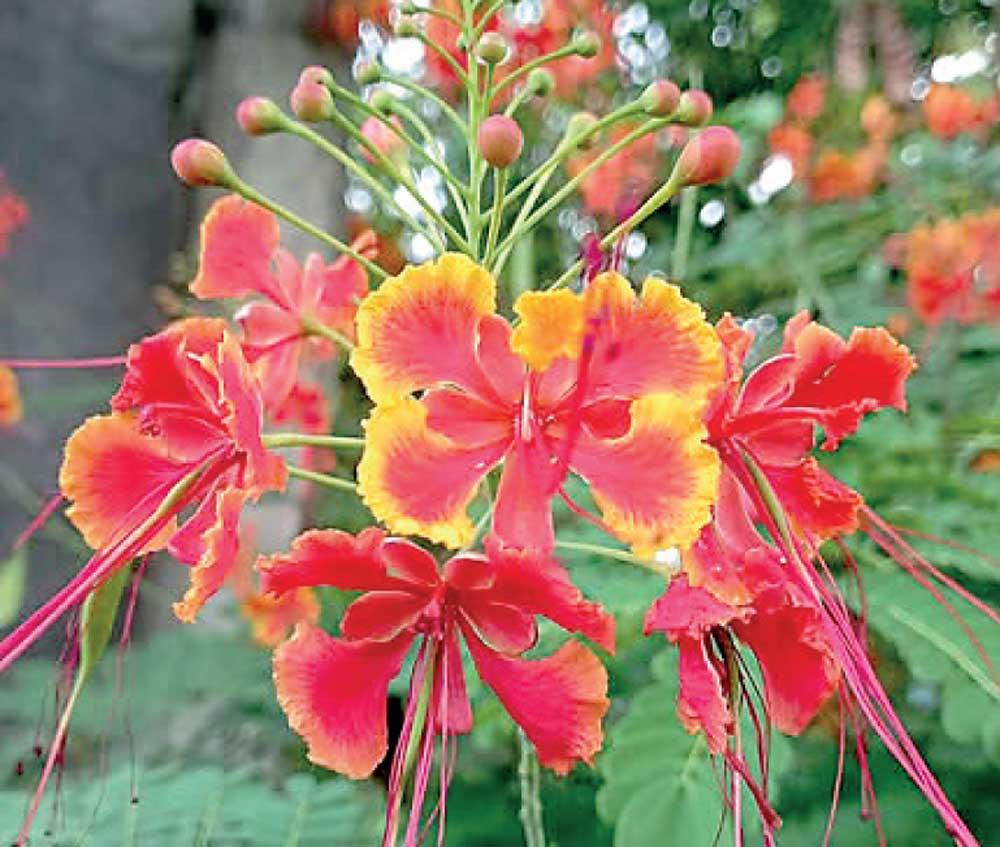Sri Lanka’s Peacock Flower (මොණර පිල). Hope for cancer patients
Posted on July 18th, 2025
Courtesy The Daily Mirror

Researchers have discovered the Peacock Flower’s potential
By Sugath Kulathunga Arachchi
In the scrublands and home gardens of Sri Lanka, where fire-orange blooms dance in the tropical heat, a quiet revolution is taking place. The peacock flower (Caesalpinia pulcherrima), long admired for its beauty and revered in traditional medicine, may hold the key to a new frontier in cancer care.
This revelation is the result of a decade-long study by researchers at the University of Colombo, led by Professor Sameera R. Samarakoon. Blending indigenous knowledge and molecular biology, their work has uncovered potent anti-cancer compounds from the peacock flower—plant-derived agents that not only destroy malignant cells but do so without harming healthy immune tissue.
At a time when cancer cases are rising globally—especially in lower-income countries where access to advanced therapies remains limited—this plant-based alternative could become a beacon of hope.
A Research Journey Rooted in Biodiversity
Sri Lanka’s rich biodiversity has long supported traditional healing systems, especially Ayurveda. Yet much of this botanical wisdom has remained undocumented or underutilised in formal science. Professor Samarakoon and his multidisciplinary team set out to change that narrative. For years, they have systematically explored native flora for bioactive compounds that might offer alternatives to synthetic drugs.
Their most recent breakthrough focuses on *Caesalpinia pulcherrima*, a widely naturalised shrub whose roots, bark, leaves, and flowers are traditionally used to treat fever, wounds, and digestive disorders. In Indonesia, its root is prescribed for childhood colic; in South Asia, the plant is known for its anti-inflammatory and anti-diarrheal properties.
Using phytochemical screening and in vitro analysis, the researchers isolated some compounds, that were known for their therapeutic potential. Lab studies revealed that these chemical agents effectively targeted multiple types of cancer cells, an unprecedented result in plant-based medicine. Initial clinical research has confirmed these findings, and discussions are now underway with pharmaceutical companies to develop the compounds into a drug suitable for human use.
Building on Past Successes
This isn’t the first time Professor Samarakoon’s team has made waves. In earlier projects, they successfully identified cancer-preventive phytochemicals from other native plants and formulated a **nutritional capsule designed to support immune defence and inhibit early-stage cancer cell growth**. That product, now commercially available through Sri Lankan health outlets, represents a tangible step toward integrating nature into modern preventive medicine.
The capsule’s success helped pave the way for more ambitious goals—like a full-scale cancer therapy derived from plants—which the peacock flower now promises to fulfill.
A Rising Health Crisis
The urgency of this research cannot be overstated. In 2022, Sri Lanka documented over 33,000 new cancer diagnoses and nearly 20,000 deaths. The age-standardised cancer incidence rate was 106.9 per 100,000 individuals, reflecting a sharp climb consistent with global trends. The World Health Organisation forecasts a 77% increase in cancer cases by 2050, with most occurring in low- and middle-income countries where medical infrastructure remains fragile.
These statistics reinforce the need for affordable, accessible treatments—especially those that can be produced locally, without reliance on costly imports or complicated synthesis.
The peacock flower’s healing potential represents more than a scientific breakthrough. It embodies a philosophy that nature—especially the flora of developing nations—can hold solutions to some of our greatest medical challenges. If this therapy is successful, it will mark a victory not just for Sri Lanka’s scientific community, but for environmental health and social equity.
It also opens a path for ethical biotech partnerships. By centering research around locally abundant and culturally meaningful plants, Sri Lanka could emerge as a global model for biodiversity-powered innovation. Professor Samarakoon’s team has emphasised sustainability and conservation throughout their process—ensuring that plant harvesting and extract development are ecologically sound.
Rediscovering the Wisdom of Wild Things
The peacock flower’s journey from ornamental beauty to medical marvel reflects a broader truth: many plants dismissed as decorative or folkloric actually possess remarkable healing powers.
Traditional medicine has long taught that *Caesalpinia pulcherrima* can treat fever, bronchitis, diarrhea, asthma, and skin ailments. Modern science now validates those uses—strengthening the case for deeper collaboration between indigenous healers and academic researchers.Earth Island Journal readers know the power of grassroots wisdom, especially when backed by rigor and cultural respect. The peacock flower is not merely a solution—it’s a symbol of what’s possible when we listen to nature.
The road to global availability is complex. Regulatory approvals, advanced trials, and scaled manufacturing lie ahead. But the University of Colombo’s team is undeterred—and they’re already in talks with pharmaceutical partners to fast-track development.
If successful, the peacock flower–based therapy could transform how the world sees natural medicine and how tropical nations assert leadership in science diplomacy.
And for Sri Lanka, it could prove that within its forests and gardens lie gifts that the world is only beginning to understand.